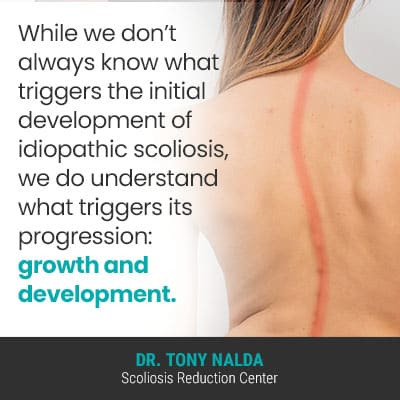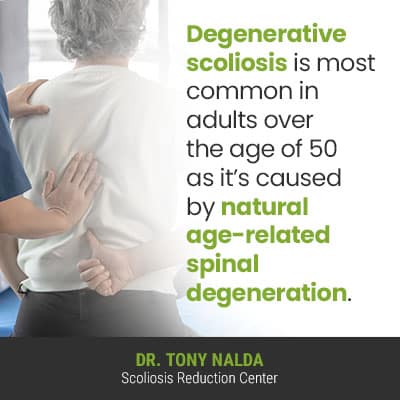Not only does scoliosis range widely in severity from mild to moderate and severe to very severe, there are also different types of scoliosis, determined by their underlying cause. In the majority of scoliosis cases, we don’t know what triggers their initial onset, but we know what triggers its progression: growth and development. Some less-prevalent types of scoliosis are associated with known causes.
Scoliosis has been around since ancient times, but there is still a lot we don’t know about the condition’s causation. Most types of scoliosis are classified as idiopathic, meaning we don’t know its cause; other condition types have known causes: neuromuscular, degenerative, and congenital scoliosis.
Part of diagnosing and assessing scoliosis involves further classifying conditions based on key patient/condition variables, one of which is cause, so let’s start with how scoliosis is first diagnosed and classified.
Diagnosing and Classifying Scoliosis
There are a number of spinal conditions a person can develop that involve a loss of its healthy curves, but there are a few features that differentiate scoliosis.
First of all, scoliosis is the development of an unnatural sideways spinal curve, but a scoliotic spine doesn’t just bend unnaturally to the side, it also twists, and it’s the rotational component that makes scoliosis a complex 3-dimensional condition.
In addition, a scoliotic curve also has to be of a minimum size: Cobb angle measurement of at least 10 degrees.
When it comes to diagnosing and assessing scoliosis, a patient’s Cobb angle is a key piece of information that tells me how far out of alignment a scoliotic spine is, along with classifying conditions based on severity:
- Mild scoliosis: Cobb angle measurement of between 10 and 25 degrees
- Moderate scoliosis: Cobb angle measurement of between 25 and 40 degrees
- Severe scoliosis: Cobb angle measurement of 40+ degrees
- Very-severe scoliosis: Cobb angle measurement of 80+ degrees
So conditions are classified based on severity, and additional classification-points are patient age, curvature location, and condition type, and as type is determined by causation, this is what we’ll be focusing on.
Where Does Scoliosis Come From?
When people ask, where does scoliosis come from, they can be wanting to know different things, but in general, people are wanting to know what triggered its development.
Now, the answer to this question also varies based on the condition type in question, so let’s start with the most prevalent form of scoliosis: idiopathic scoliosis.
Idiopathic scoliosis is the most common type to affect both children and adults, and the idiopathic designation means not clearly associated with a single-known cause; idiopathic scoliosis is, instead, considered to be multifactorial, meaning caused by a combination of variables that can change from person to person.
Adolescent idiopathic scoliosis (AIS), diagnosed between the ages of 10 and 18, is the most common type of scoliosis overall.
Approximately 80 percent of known diagnosed scoliosis cases involve idiopathic scoliosis, and the remaining 20 percent of cases are associated with known causes: neuromuscular scoliosis, degenerative scoliosis, and congenital scoliosis.
There are a number of theories that attempt to explain the causation of idiopathic scoliosis from connections to low body mass index (BMI) to vitamin deficiencies, to muscular and bone-formation issues, but they are just that: theories.

While we don’t always know what triggers the initial development of idiopathic scoliosis, we do understand what triggers its progression: growth and development.
So children and adolescents who still have a lot of growth yet to go through can be at risk for rapid-phase progression.
As a progressive condition, where a scoliosis is at the time of diagnosis is not indicative of where it will stay, especially without the help of proactive treatment that works towards counteracting its progressive nature.
So now that we’ve explored the causation behind the most common type of scoliosis (idiopathic), let’s move on to the other 20 percent that are associated with known causes.
Neuromuscular Scoliosis
Cases of neuromuscular scoliosis (NMS) are considered atypical as they are caused by the presence of a larger neuromuscular condition such as muscular dystrophy, cerebral palsy, and spina bifida, to name a few.
I can’t give my neuromuscular scoliosis patients the same types of prognoses that I can with my typical idiopathic scoliosis patients because the larger neuromuscular condition has to be the focus of treatment, and this complicates the treatment process.
Neuromuscular scoliosis involves a disconnect between the brain and the muscles and connective tissues that support the spine, and this can cause the development of an unnatural spinal curve.
While not everyone with a neuromuscular condition will automatically develop scoliosis, it is a common complication, with some patients becoming non-ambulatory (unable to walk on their own and wheelchair bound).
So cases of neuromuscular scoliosis are caused by the presence of a larger underlying neuromuscular condition.
Degenerative Scoliosis
After idiopathic scoliosis, degenerative scoliosis is the next most common type to affect adults, and degenerative scoliosis is caused by natural age-related spinal degeneration, and the cumulative effect of certain lifestyle factors.
There is a certain amount of spinal degeneration to be expected with age, but certain lifestyle factors can increase the rate and severity of age-related spinal degeneration: carrying excess weight, low activity levels, chronic poor posture, excessive consumption of alcohol/smoking, and repeatedly lifting heavy objects incorrectly.
In most cases of spinal degeneration, it’s the spine’s intervertebral discs that are the first spinal structures to start to deteriorate, and the discs give the spine flexibility, provide cushioning between adjacent vertebrae to avoid friction during movement, act as the spine’s shock absorbers, and give the spine structure as adjacent vertebrae attach to the disc in between.
Degenerative disc disease can be the cause of a number of spinal conditions as disc degeneration can affect the spine’s ability to maintain its natural curves and alignment.
Degenerative scoliosis is more common in females than males, and this is understood as a result of bone density and hormone changes related to menopause.

Degenerative scoliosis is most common in adults over the age of 50 as it’s caused by natural age-related spinal degeneration.
Congenital Scoliosis
When people ask, what kind of scoliosis are you born with, they are referring to congenital scoliosis.
Congenital scoliosis is a rare form affecting approximately 1 in 10,000, and it is caused by a malformed spine that develops in utero, so babies are born with the condition.
In these cases, it’s not uncommon for these patients to also have other issues related to malformed systems and parts within the body, so they should be assessed and monitored closely.
Congenital scoliosis involves a structural abnormality within the spine itself, and this can involve a failure of vertebral bodies to separate and form into distinct vertebrae, instead becoming fused together, or when a vertebra is more triangular in shape, than rectangular, causing the spine to wedge forward and develop an unnatural scoliotic curve.
Conclusion
Despite the fact that scoliosis has been around for hundreds of years, we still have a lot to learn about the condition, and its complex nature necessitates a customized treatment approach; each case is unique.
Not only is scoliosis a progressive condition whose nature is to get worse over time, it can also range widely in severity from mild to moderate and severe to very severe, affect all ages, develop anywhere along the spine, and there are multiple condition types.
Condition type is determined by causation, and when a ocndition’s cause is known, it has to inform the crafting of effective treatment plans.
In idiopathic scoliosis, we don’t know what causes it, so we focus on what triggers its progression by working towards counteracting the effect of growth and development.
In neuromuscular scoliosis, the underlying neuromuscular condition has to be the focus of treatment as the scoliosis developed as a secondary complication of a larger medical condition.
In cases of degenerative scoliosis, the treatment focus is on preserving as much spinal function as possible, preventing further damage, and improving the spine’s flexibility and support.
Congenital scoliosis poses some unique challenges associated with treating scoliosis in such young patients, so treatment plans have to be modified, and monitoring closely for signs of progression, and/or additional abnormalities, during growth is another focus of treatment.
Here at the Scoliosis Reduction Center®, patients are treated with a proactive conservative chiropractic-centered treatment approach that strives to preserve as much of the spine’s natural strength and function as possible, while working towards a curvature reduction on a structural level, and increasing core strength through physical therapy so the spine’s surrounding muscles can provide it with optimal support.
While it can be difficult for patients recently diagnosed with idiopathic scoliosis to explain that the answer to the question, where does scoliosis come from, remains unknown, I like to point out that knowing its causation wouldn’t necessarily change the course of treatment, or its outcome.
What’s most important about treatment efficacy is when treatment is started, and the best time to start treatment for all types and severity levels of scoliosis is always now.




